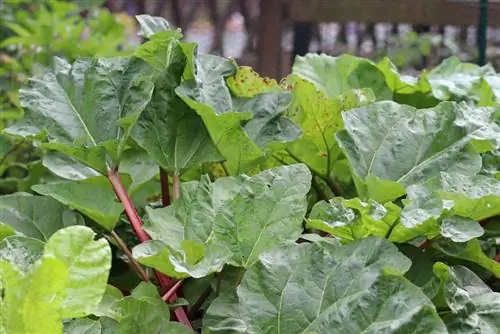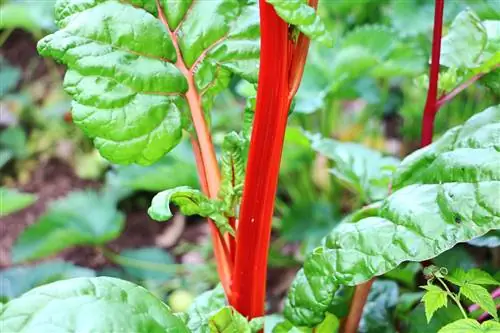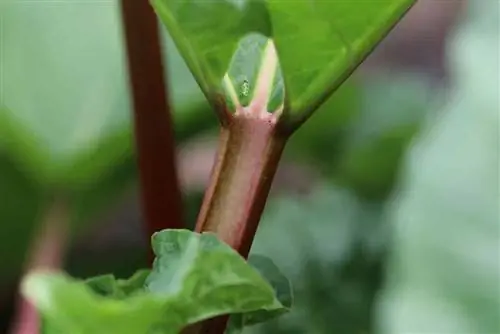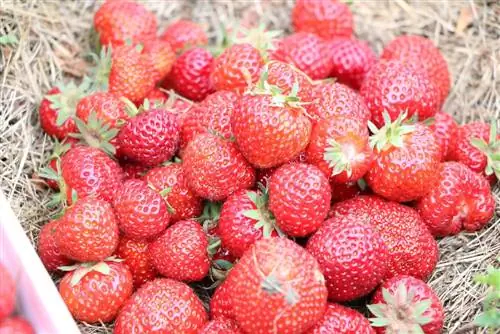- Author admin [email protected].
- Public 2023-12-17 03:39.
- Last modified 2025-06-01 06:48.
Fruity, pleasantly sour and he althy - rhubarb is one of the most popular plant products in our part of the world; As a basis for desserts such as compotes or cakes, it gives every dish a fruity, sour note and at the same time impresses with its pleasantly fibrous consistency. Grown in a sheltered spot in the garden, rhubarb can easily sprout and then become overabundant; then all sticks that can no longer be eaten fresh must be preserved. There are different options available for this.
Preserving rhubarb - options
If you want to enjoy your rhubarb all year round, you have to preserve the vegetable. This works with the following methods:
- Freezing
- Canning (as compote)
- make jelly
It should be noted that the last two methods already have limitations in their use; If you want to leave all possible preparation options open, choose freezing as a preservation method.
Preparations: Clean, peel and blanch rhubarb
Before the rhubarb can be preserved, the stalks must be prepared. To do this, first remove all leaves and dry areas and then rinse the red stalks thoroughly under running water. After draining, the hard ends are generously cut off. Whether the rhubarb needs to be peeled afterwards depends on its condition.
Tip:
Rhubarb only needs to be peeled if the top layers can be easily removed with bare fingers.
There are also varieties with a particularly soft outer layer; With these, additional peeling is not necessary. All other varieties are peeled as follows:
- attach to the cut surface
- Grasp fibers with two fingers
- then peel it off lengthways
If you don't want the rhubarb to take on a gray-brown shade during further processing, you should blanch the stalks after peeling them; then the vegetables retain their pretty red color. To do this, use a sieve to place the rhubarb in boiling water for about a minute and then immediately rinse the pieces with cold water. The vegetables are blanched especially if freezing is desired as a preservation method.
Freeze rhubarb
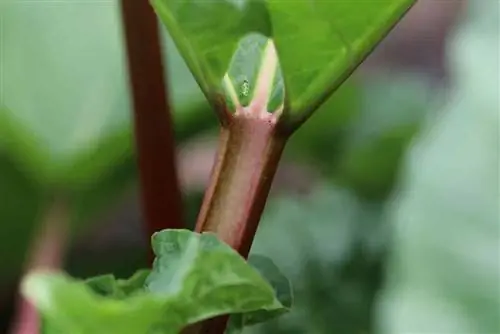
Basically, freezing rhubarb is done after cutting the stalks into bite-sized pieces. It has proven useful to pre-freeze the rhubarb first:
- First freeze rhubarb pieces spread out next to each other
- A baking sheet, a tray or a cutting board is suitable for laying out
- Pieces should not touch each other
- freezing time is two to three hours
If you choose this method, you ensure that the individual pieces do not freeze and stick together. You can portion the rhubarb much better later. The rhubarb pieces can then be placed in freezer bags or containers. Freezer bags should best be sealed with a seal or vacuum sealed. As with any frozen food, the less air gets to the sticks, the longer the flavor lasts. In addition, the risk of freezer burn is significantly reduced. Rhubarb will last up to a year in the freezer or freezer this way. When thawed, the pieces are often a little mushy; However, this says nothing about the quality of the rods.
Another way to preserve in ice is to use the juice bath method:
- Choose juices with a low acid content
- Grape juice or peach juice are suitable
- Pour juice over the prepared pieces
- put in freezer bag and put in freezer
- defrost in the microwave for processing
With this method, the sugar gives the vegetables their very own aromatic taste and is also protected from drying out.
Preserving rhubarb by boiling
Before cooking, it is advisable to choose the rhubarb variety wisely; Depending on whether you use green or red sticks, different flavor nuances can be expected. While the green stalks are very sour, red rhubarb tastes sweet; Those varieties whose skin and pulp are red in color are particularly mild. Gourmets often taste a raspberry-like note here.
After selecting a suitable rhubarb variety, the necessary utensils can be prepared. To make the preserves you need a large pot, water, sugar or sweetener, as well as vegetables and jam jars with screw caps. When preserving, the following aspects should be taken into account:
- Ratio should be 3:1: 0.5 (rhubarb: water: sugar)
- You can also avoid water completely for a more intense taste
- Add sugar to the sliced rhubarb
- Let the mixture steep for half an hour

If you want to save calories, use sweetener instead of sugar; Rhubarb can also be sweetened with stevia. Lemon juice, orange peel or scraped vanilla pods can also be used to refine the compote; they give the dessert its own unique touch. After steeping, the rhubarb is boiled; To do this, let the mixture simmer until the compote has achieved the desired consistency. Transfer into the prepared jam jars when the mixture is still hot; then it is poured in and carefully sealed. It is then necessary to place the glasses in a water bath for another quarter of an hour. Alternatively, it is also possible to turn the jars upside down after filling for optimal preservation.
Tip:
In order to ensure that the compote lasts as long as possible, it is important that the jars have been sterilized in advance. To do this, they are first cleaned thoroughly and then washed out with boiling water.
Preserved in this way, rhubarb lasts for several months. It is not necessary to additionally cool the glasses; the compote is stored in the pantry. Only opened jars should be kept cool.
The processing of the compote is very varied: the sweet and sour mixture is traditionally served with desserts such as pudding or cake; But savory dishes, such as duck breast, can also be refined with the compote.
Preserving rhubarb as jelly
Finally, an excess supply of rhubarb can also be made into tasty jelly. However, since it is generally a rather sour vegetable, it is a good idea to combine rhubarb with a sweet fruit, for example strawberries. Such a jelly can be made very easily:
- Wash strawberries and rhubarb and roughly chop them
- Juicing pieces
- Mix juice with preserving sugar
- Bring the mixture to the boil and then let it cook for 4 minutes while stirring
- Finally pour into jam jars and close tightly
The amounts of the individual ingredients may vary depending on your personal recipe. Whether as jam, compote or frozen - rhubarb can be used in a variety of ways. And if you preserve your favorite vegetables optimally, you can enjoy the fruity-sour note of the tasty sticks all year round.

